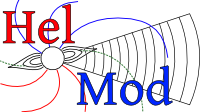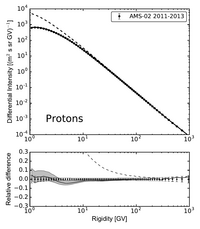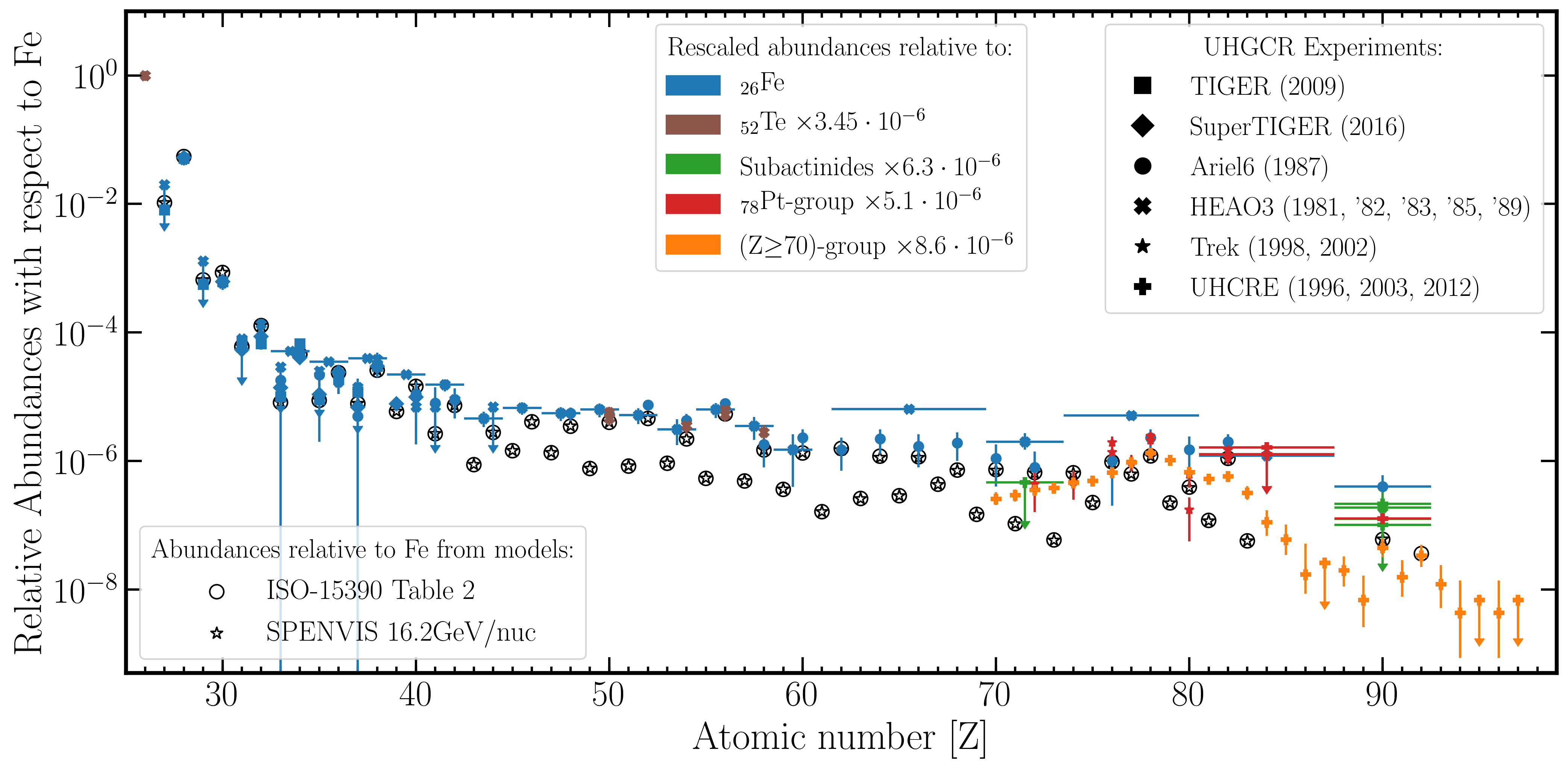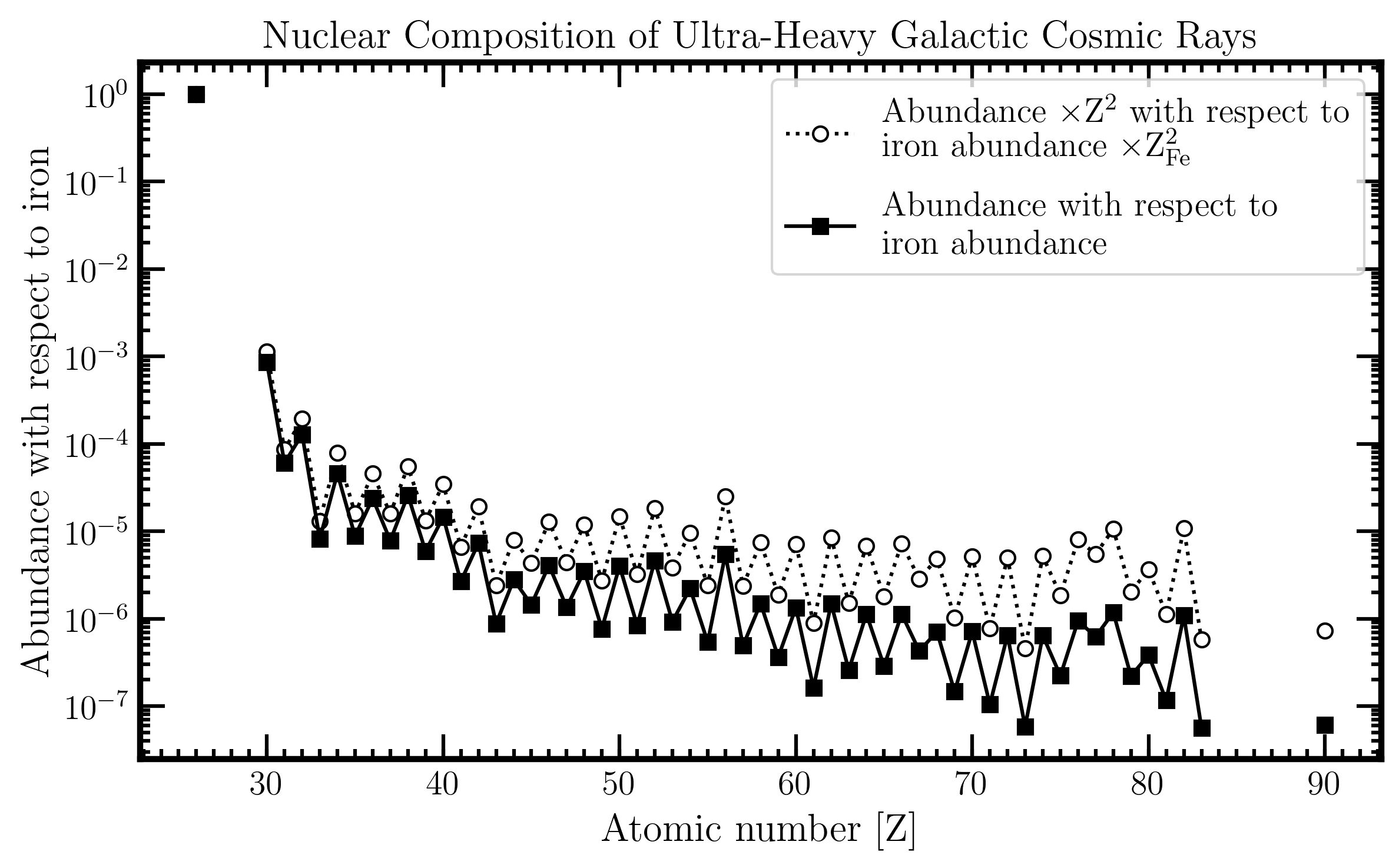At present, the HelMod modulated spectra framework does not include ultra-heavy galactic cosmic ray ions (UHGCRs, i.e., GCRs with Z>28) due to their expected negligible contribution to the radiation risk evaluation (e.g., SEE rate) in space, particularly when compared to the impact of iron (see Appendix A in Boschini et al. 2024).
UHGCRs are GCRs that are heavier than nickel, i.e. with a nuclear charge larger than 28. The origin of UHGCRs is a long-standing and important question in the fields of astronomy and astrophysics (see recent reviews inWiedenbeck et al., 2007; Lingenfelter, 2019; Tatischeff et al., 2021, and references therein). Due to their rarity, measuring their abundance is extremely challenging, and their spectral shape as a function of energy is still unknown. Data mainly consists of ratios of elements or groups of elements in an unspecified energy band. This is due to the limitations of the detectors used to evaluate the abundance, which is typically measured in a range of energies around a few GeV/nucleon.
Fig. 1. Relative abundances of GCRs from iron (Z=26) to berkelium (Z=97). Open circles represent GCR relative abundances taken from Table 2 of the ISO-15390 model (ISO, 2004). SPENVIS spectra at 16.2 GeV/nucleon are also shown as open stars. These values have been compared with the relative abundance measurements of UHGCRs from various experiments collected in CRDB (Maurin et al., 2020). Different colors refer to abundances measured with respect to the abundance of the ion or the group of ions reported in the respective color legend label; multiplicative factors are used to rescale these values to the Fe abundance. [Figure from Boschini et al. (2024)]
Abundance measurements of UHGCR are available in the Cosmic-Ray DataBase (CRDB, Maurin et al., 2014, 2020). Figure 1 shows their values normalized to the iron abundance plotted against the atomic number Z. The most recent measurements in the Z=30-40 range are from the SuperTIGER experiment (Rauch et al., 2009; Murphy et al., 2016). However, experiments in the high charge range date back mainly to the late 70s to late 90s of the last century, such as HEAO3 (Binns et al., 1981, 1982, 1983, 1985, 1989), ARIEL6 (Fowler et al., 1987), UHCRE (Domingo et al., 1996; Dutta et al., 2003; Donnelly et al., 2012), and Trek (Westphal et al., 1998; Weaver & Westphal, 2002). Figure 1 also shows abundances relative to iron for "non-modulated" spectra, listed in Table~2 of the ISO-15390 report (ISO, 2004). This model is recognized by the ECSS guidelines (e.g., see ECSS, 2020) as the standard model to assess the space radiation environment. The Figure also reports ratios of UHGCR fluxes and the iron flux, obtained by the ISO-15390 model implemented in ESA’s SPace ENVironment Information System (SPENVIS, https://www.spenvis.oma.be/), at 16.2 GeV/nucleon —at this energy the solar modulation effects can be considered negligible.
Fig. 2. Relative abundances (black-filled squares) and relative abundances multiplied by Z2 (open circles) of GCRs at 16.2 GeV/nucleon, normalized to the iron abundance, as a function of the atomic number Z. The plot ranges from copper (Z=29) to uranium (Z=92). [Figure from Boschini et al. (2024)]
Figure 2 displays the ratio of GCR abundances from copper (Z=29) to uranium (Z=92) and the iron flux at 16.2 GeV/nucleon, obtained from SPENVIS, as a function of the atomic number Z. Additionally, the relative abundances are also shown multiplied by Z2, considering that the collision energy-loss in matter at sufficiently high energies is proportional to Z2. It is observed from the plot that the total amount of energy loss experienced by UHGCRs in the matter is less than 0.5% of the iron energy loss. Therefore, the contribution of UHGCRs to the radiation hazard in space, such as the SEE rate, can be considered negligible.
Bibliography
Boschini et al (2024), Fast and accurate evaluation of deep-space galactic cosmic ray fluxes with HelMod-4/CUDA, M. J. Boschini, G. Cavallotto, S. Della Torre, M. Gervasi, G. La Vacca, P. G. Rancoita, M. Tacconi, Advances in Space Research, April 2024, In Press
Binns, W. R., Fickle, R. K., Waddington, C. J. et al. (1981) Cosmic-ray abundances of elements with atomic number 26 less than or equal to 40 measured on HEAO 3. ApJ, 247, L115–L118. doi:10.1086/183602.
Binns, W. R., Israel, M. H., Klarmann, J. et al. (1982). The abundance of the actinides in the cosmic radiation as measured on HEAO 3. ApJ, 261, L117–L120. doi:10.1086/183899
Binns, W. R., Israel, M. H., Klarmann, J. et al. (1983). Cosmic-ray abundances of Sn, Te, Xe, and BA nuclei measured on HEAO 3. ApJ, 267, L93–L96. doi:10.1086/184010.
Binns, W. R., Israel, M. H., Brewster, N. R. et al. (1985). Lead, platinum, and other heavy elements in the primary cosmic radiation - HEAO 3 results. ApJ, 297, 111–118. doi:10.1086/163508.
Binns, W. R., Garrard, T. L., Gibner, P. S. et al. (1989). Abundances of Ultra-heavy Elements in the Cosmic Radiation: Results from HEAO 3. ApJ, 346, 997. doi:10.1086/168082.
Domingo, C., Font, J., Baixeras, C. et al. (1996). Source abundances of ultraheavy elements derived from UHCRE measurements. Radiation Measurements, 26(6), 825–832. doi:10.1016/S1350-4487(96)00090-X.
Donnelly, J., Thompson, A., O’Sullivan, D. et al. (2012). Actinide and Ultra-Heavy Abundances in the Local Galactic Cosmic Rays: An Analysis of the Results from the LDEF Ultra-Heavy Cosmic-Ray Experiment. ApJ, 747(1),40. doi:10.1088/0004-637X/747/1/40.
Dutta, A., Batra, V., & Biswas, S. (2003). Abundance of actinides in cosmic radiation. Radiation Measurements, 36(1-6), 287–290. doi:10.1016/S1350-4487(03)00137-9.
ECSS (2020). Space Environment. Technical Report ECSS-E-ST-10-04C Rev.1 European Cooperation for Space Standardization, ESA. URL: https://ecss.nl/standard/ecss-e-st-10-04c-rev-1-space-environment-15-june-2020/
Fowler, P. H., Walker, R. N. F., Masheder, M. R. W. et al. (1987). Ariel Measurements of the Fluxes of Ultra-heavy Cosmic Rays. ApJ, 314, 739. doi:10.1086/165101
ISO (2004). Space Environment (Natural and Artificial) - Galactic Cosmic Ray Model. Standard International Organization for Standardization Geneva, CH. URL: https://www.iso.org/standard/37095.html.
Lingenfelter, R. E. (2019). The Origin of Cosmic Rays: How Their Composition Defines Their Sources and Sites and the Processes of Their Mixing,Injection, and Acceleration. ApJS, 245(2), 30. doi:10.3847/1538-4365/ab4b58.
Maurin, D., Dembinski, H. P., Gonzalez, J. et al. (2020). Cosmic-Ray DatabaseUpdate: Ultra-High Energy, Ultra-Heavy, and Antinuclei Cosmic-Ray Data(CRDB v4.0). Universe, 6(8), 102. doi:10.3390/universe6080102.
Maurin, D., Melot, F., & Taillet, R. (2014). A database of chargedcosmic rays. A&A, 569, A32. doi:10.1051/0004-6361/201321344.
Murphy, R. P., Sasaki, M., Binns, W. R. et al. (2016). Galactic Cosmic RayOrigins and OB Associations: Evidence from SuperTIGER Observations ofElements 26Fe through 40Zr. ApJ, 831(2), 148. doi:10.3847/0004-637X/831/2/148.
Rauch, B. F., Link, J. T., Lodders, K. et al. (2009). Cosmic Ray origin in OB Associations and Preferential Acceleration of Refractory Elements: Evidence from Abundances of Elements 26Fe through 34Se. ApJ, 697(2), 2083–2088. doi:10.1088/0004-637X/697/2/2083.
Tatischeff, V., Raymond, J. C., Duprat, J. et al. (2021). The origin of Galacticcosmic rays as revealed by their composition. MNRAS, 508(1), 1321–1345.doi:10.1093/mnras/stab2533.
Weaver, B. A., & Westphal, A. J. (2002). Extended Analysis of the Trek Ultra-heavy Collector. ApJ, 569(1), 493–500. doi:10.1086/339265.
Westphal, A. J., Price, P. B., Weaver, B. A. et al. (1998). Evidence againststellar chromospheric origin of Galactic cosmic rays. Nature, 396(6706),50–52. doi:10.1038/23887
Wiedenbeck, M. E., Binns, W. R., Cummings, A. C. et al. (2007). An Overviewof the Origin of Galactic Cosmic Rays as Inferred from Observations ofHeavy Ion Composition and Spectra. Space Sci. Rev., 130(1-4), 415–429.doi:10.1007/s11214-007-9198-y




